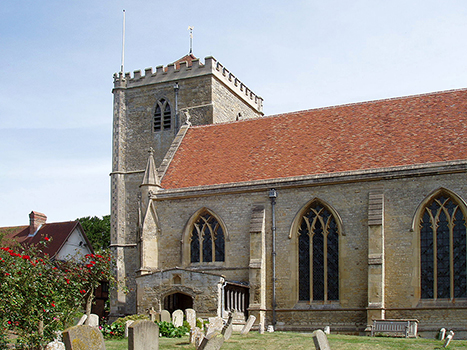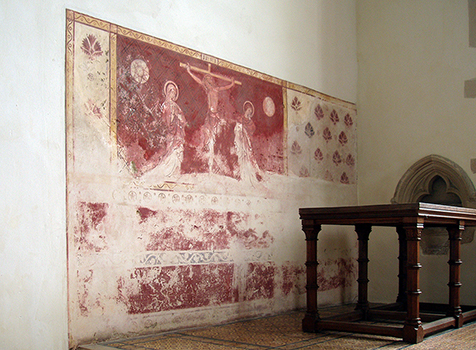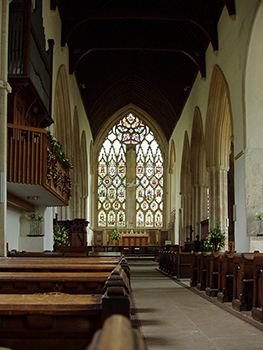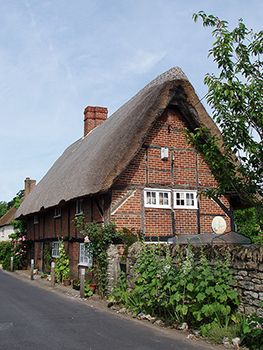DORCHESTER ON THAMES, OXFORDSHIRE
Grid Ref: SU 568 947
21 June 2003
 |
 |
 |
| The Abbey Church of St. Peter and St. Paul |
|
The nave and People's chapel |
 |
|
 |
| The 14th century wall painting in the People's chapel |
|
The Nave |
 |
|
 |
| Font of 1170 |
|
Timber framed house |
 |
|
 |
| Coach in front of the George Hotel |
|
Thatched cottage with hollyhocks |
Dorchester on Thames in Oxfordshire has an Iron Age hill fort,
it became a Roman town then an Anglo-Saxon settlement. The reintroduction
of Christianity into the central region of England came in 635 when Oswald,
King of Northumbria and a Christian, met the pagan King Cynegils near Dorchester
on Thames, which was then in Wessex. As a result, Cynegils was baptised into
the church by Birinus and Oswald married Cynegils' daughter. Birinus became
a bishop with his seat at Dorchester on Thames and a cathedral was built.
Birinus was buried at Dorchester in 650. In the 660s, the threat of war between
Wessex and Mercia led to the see being relocated in Winchester. Dorchester
was incorporated into the see of Leicester until the invasion of the Danes.
Dorchester then became the centre for a Mercian diocese stretching from the
Thames to the Humber and covering what are now nine counties. After the Norman
Conquest, William I decided that all his cathedrals should be in fortified
cities. The first Norman Bishop of Dorchester was Remigius; he moved the seat
to Lincoln in the 1070s. Dorchester continued to operate with secular cannons
until it was refounded by Alexander of Lincoln in 1140 as an Augustinian abbey.
A new church was then built, the west end of which survives as the current
nave.
A similar story relates how Elfleda, daughter of King Oswy of
Northumbria, married Peada, son of King Penda on the understanding that he
became a Christian and was baptised by Finan, Bishop of Lindisfarne. Peada
became the first Christian King of all of Mercia. Peada and Oswy then founded
a monastery dedicated to St. Peter at Medehamstede, modern Peterborough.
Birinus was created a saint and Dorchester became a pilgrimage
site after 1225 when the tomb of Birinius was opened. The church was enlarged
in the 13th century with the addition of the north aisle between 1220 and
1250. In 1320 a south aisle was built. This latter was towards the west end
in about 1340 an area to be used as the parish church and is now the People's
Chapel, shown in the photograph. In 1340 the chancel was extended to produce
the sanctuary. The tower was rebuilt in 1602, replacing one of about 1370.
At the Dissolution, in 1536, the shrine of St. Birinus was destroyed and the
Abbey Church was bought for the town by Richard Beauforest. The domestic buildings
for the Abbey were destroyed. As a parish church, it is far too big for the
town and has consequently been difficult to maintain. In June 2000 an appeal
for £5 million was launched by the Lord Lieutenant of Oxfordshire. A
new heating system, installed in 2002, has made the abbey suitable for a variety
of uses including concerts. The shrine area in the south aisle was refurbished
in 2001 and archaeological investigations are being carried out in a 4-year
programme. .
The Norman font is a rare survival; many richly decorated fonts
were destroyed either at the Dissolution or during the English Civil War.
Sources:
Dorchester Abbey, Oxfordshire, text by Rosalie Bloxham, pictures
by Frank Blackwell, printed by Severnprint, Gloucester, a booklet available
in the abbey.
Encyclopaedia Britannica on CD ROM
England in the Early Middle Ages, three lectures by James
Bond at Wedgwood Memorial College, Barlaston, Staffs, Autumn 2002.








